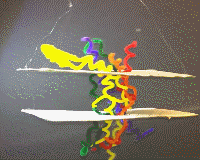Tutorial:The opioid receptor, a molecular switch
From Proteopedia
(→Natural Function) |
(→Natural Function) |
||
| Line 12: | Line 12: | ||
Once this has transpired, a new molecule gets released into the cell. This compound, known as [[Arrestin]], creates more changes in the cell's internal environment. These changes first result in the opioid receptor being encapsulated in a membrane and dragged into the cell, which, due to increased acidity, ejects the bound opioid. Then, one of 2 events may occur with the opioid receptor itself. The first results in the receptor being returned to the cell's membrane for further use, and the second results in the receptor being broken down inside the cell to be later recycled entirely. | Once this has transpired, a new molecule gets released into the cell. This compound, known as [[Arrestin]], creates more changes in the cell's internal environment. These changes first result in the opioid receptor being encapsulated in a membrane and dragged into the cell, which, due to increased acidity, ejects the bound opioid. Then, one of 2 events may occur with the opioid receptor itself. The first results in the receptor being returned to the cell's membrane for further use, and the second results in the receptor being broken down inside the cell to be later recycled entirely. | ||
| - | For further information, | + | For further information, referenced is a 4:35 video providing visuals and a general overview of the above information. |
[https://www.youtube.com/watch?v=8BcINeVoOWQ] | [https://www.youtube.com/watch?v=8BcINeVoOWQ] | ||
Revision as of 16:08, 9 December 2019
The opioid receptor, a protein on the surface of nerve cells, binds to opioids such as morphine, oxicodone, heroin, and fentanyl. Repeated intake of opioids changes the response to these molecules, and can lead to addiction. This article explains, at a level appropriate to high school students or beginning college students, how the opioid receptor is switched on and off, and what happens inside the brain as a consequence.
Contents |
Relevance
When we want to turn on the lights in a dark room, we don't have to climb up a ladder to screw in a light bulb. All we have to do is flip a switch. A biological cell has switches, too, called receptors. Most are on the cell surface with a part sticking out, ready to bind to a signaling molecule. Another part of the receptor reaches into the inside of the cell, transmitting the signal. The opioid receptor can be switched on to relieve pain, for example during surgery. Tragically, it is very easy to become physically dependent on the signaling molecules. The ongoing opioid crisis in the USA shows how addictive opioids are (e.g. morphine, oxicodone, heroin, and fentanyl), with overdose deaths decreasing average life expectancy across the US population significantly.
Natural Function
The Mu Opioid Receptor is a protein construct found in the membrane of neurons. The human body has many opioid receptors; however these in particular react with morphine and other similar opioids involved in the 2010s Opioid Crisis. As of the late 2010s, the molecular shape of these mu opioid receptors has been discovered and documented.
These opioid receptors interact with opioids via a process known as Ligand Binding[1]. During this, an opioid molecule binds to the opioid receptor, resulting in what is known as conformational change[2]. This alters the shape of the receptor, causing it to release a GTP-binding protein (otherwise known as a G protein), which functions as the on/off switch of the cell's pain and dopamine receptors. When the G protein is released, it in turn binds to the pain receptor and the Dopamine receptor, causing the former to stop releasing pain signals, and the latter to release dopamine, which causes the body's pain to numb and the body to experience pleasure, respectively.
Once this has transpired, a new molecule gets released into the cell. This compound, known as Arrestin, creates more changes in the cell's internal environment. These changes first result in the opioid receptor being encapsulated in a membrane and dragged into the cell, which, due to increased acidity, ejects the bound opioid. Then, one of 2 events may occur with the opioid receptor itself. The first results in the receptor being returned to the cell's membrane for further use, and the second results in the receptor being broken down inside the cell to be later recycled entirely.
For further information, referenced is a 4:35 video providing visuals and a general overview of the above information. [3]
Disease and treatment
Talk about pain medication, drug abuse and overdose treatment with naloxone here. Links to other four videos at appropriate sections.
Structural highlights
| |||||||||||

